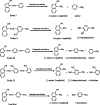Anaerobic metabolism of 1-amino-2-naphthol-based azo dyes (Sudan dyes) by human intestinal microflora
- PMID: 17933925
- PMCID: PMC2168037
- DOI: 10.1128/AEM.01410-07
Anaerobic metabolism of 1-amino-2-naphthol-based azo dyes (Sudan dyes) by human intestinal microflora
Abstract
The rates of metabolism of Sudan I and II and Para Red by human intestinal microflora were high compared to those of Sudan III and IV under anaerobic conditions. Metabolites of the dyes were identified as aniline, 2,4-dimethylaniline, o-toluidine, and 4-nitroaniline through high-performance liquid chromatography and liquid chromatography electrospray ionization tandem mass spectrometry analyses. These data indicate that human intestinal bacteria are able to reduce Sudan dyes to form potentially carcinogenic aromatic amines.
Figures



References
-
- An, Y., L. Jiang, J. Cao, C. Geng, and L. Zhong. 2007. Sudan I induces genotoxic effects and oxidative DNA damage in HepG2 cells. Mutat. Res. 627:164-170. - PubMed
-
- Bromley-Challenor, K. C. A., J. S. Knapp, J. Zhang, N. C. C. Graz, M. J. Hetheridge, and M. R. Evans. 2007. Decolorization of an azo dye by unacclimated activated sludge under anaerobic conditions. Water Res. 34:4410-4418.
-
- Budavari, S., and M. J. O'Neil (ed.). 2001. The Merck index: an encyclopedia of chemicals, drugs and biologicals, p. 1505-1583. Merck & Co., Rahway, NJ.
-
- Calbiani, F., M. Careri, L. Elviri, A. Mangia, L. Pistara, and I. Zagnoni. 2004. Development and in-house validation of a liquid chromatography-electrospray-tandem mass spectrometry method for the simultaneous determination of Sudan I, Sudan II, Sudan III and Sudan IV in hot chilli products. J. Chromatogr. A 1042:123-130. - PubMed
-
- Cerniglia, C. E., J. P. Freeman, W. Franklin, and L. D. Pack. 1982. Metabolism of benzidine and benzidine-congener based dyes by human, monkey and rat intestinal bacteria. Biochem. Biophys. Res. Commun. 107:1224-1229. - PubMed
Publication types
MeSH terms
Substances
LinkOut - more resources
Full Text Sources
Other Literature Sources

